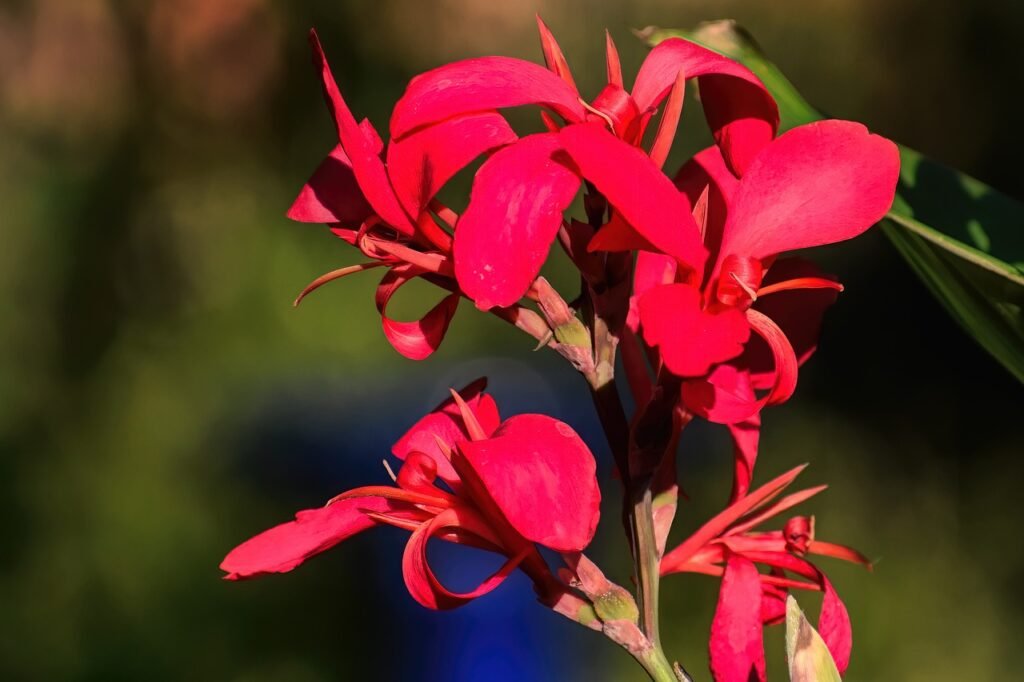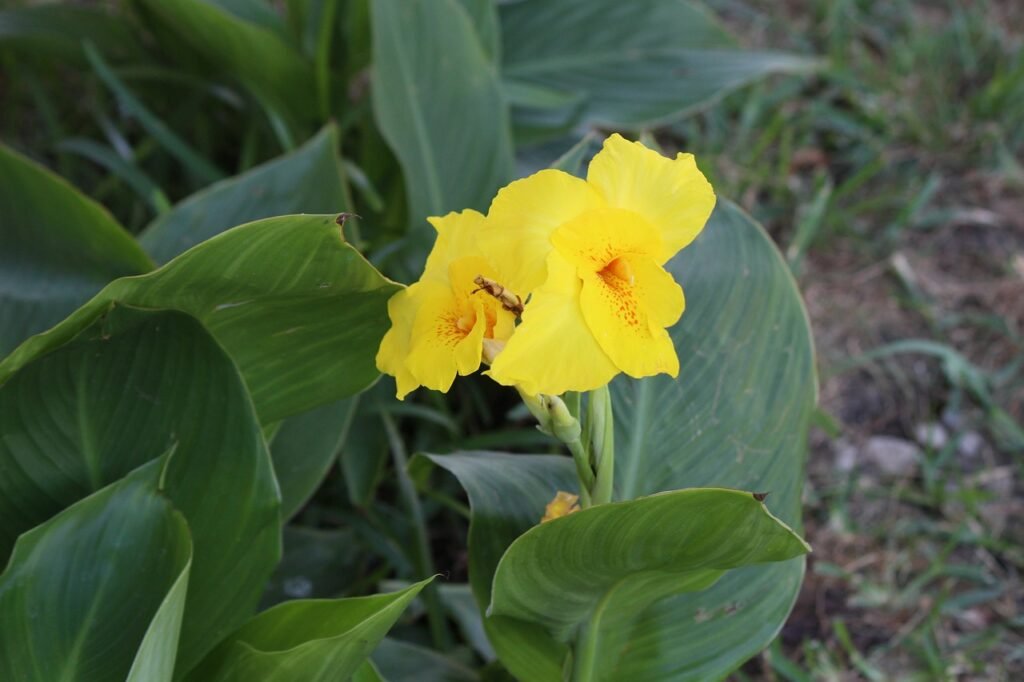
Table of Contents
Introduction To Canna Lily Care
Canna lilies, known for their vivid and exotic blossoms, are popular choices among gardeners wishing to add a tropical touch to their landscapes. Their fascinating presence, defined by strong foliage and beautiful blossoms, appeals to both new and experienced gardeners. Canna lilies are known for their ease of maintenance and make a diverse and delightful addition to any garden.

In the sections that follow, we will look at the fundamentals of canna lily care, offering useful insights and practical advice for effective growing and brilliant displays of these gorgeous plants in your yard.
Choosing the Right Location
Creating the ideal setting for canna lilies requires deliberate considerations about solar exposure and soil conditions. These tropical beauties thrive in full sunlight, so choose a garden space that receives 6-8 hours of direct sunlight per day. Sunlight not only drives their growth, but also brightens the colour of their beautiful blossoms.
The type of soil used is also important. Canna lilies dislike standing water and require well-drained soil to avoid soggy situations. Choose soil that promotes efficient water permeation, protecting the plants from potential root rot. Increase soil fertility by introducing plenty of organic matter, which provides vital nutrients for healthy growth.
Furthermore, maintaining a slightly acidic soil pH is beneficial to canna lily development. A soil test allows you to modify the acidity levels, ensuring an atmosphere conducive to nutrient absorption. By methodically addressing these elements, you create a thriving refuge in which canna lilies can display their vivid blossoms in all their tropical glory.
Planting
Planting canna lilies is a simple but important step in ensuring their healthy growth and spectacular displays. To begin, dig a hole of moderate depth (4-6 inches) to form a good bed for the rhizome. Place the rhizome horizontally within the hole, making sure to align the eyes or growing points upward. Cover the rhizome carefully with dirt, ensuring a snug but not extremely compressed environment.

After planting, thoroughly wet the soil to settle it and let the canna lily establish itself. Adequate moisture is required during the early stages to promote root formation. Furthermore, to promote healthy growth and reduce the danger of disease, space numerous canna lilies 18 to 24 inches apart. This spacing allows for optimum air circulation, which reduces the possibility of fungal problems and ensures that each plant has the space to grow to its maximum potential. Following these planting instructions lays the groundwork for a healthy and flourishing canna lily garden.
Watering
Canna lilies caring requires a specific moisture balance to thrive. While they thrive in dependably moist soil, overwatering is not recommended as it might cause rot. To establish the appropriate balance, water your canna lilies on a regular basis, especially during dry times, to keep the soil moist.
A useful idea is to let the top inch of soil dry between watering sessions. This approach keeps the canna lilies from being soggy, which can lead to root rot and fungal problems. Mulching at the base of the plants helps regulate moisture levels. Mulch not only retains soil moisture but also works as a weed barrier, reducing competition for water and nutrients. Following these watering and mulching procedures helps your canna lilies’ general health and vitality, creating an environment in which they can grow and show off their brilliant beauty.
Fertilizing
Canna lilies require a well-executed fertilisation practice to grow vigorously and flower abundantly. Fertilising these plants during the growing season is vital for supporting their lush foliage and producing numerous blooms. Choose a balanced fertiliser or one with a slightly higher phosphorus content, as phosphorus is important for flowering stimulation.

Apply the specified fertiliser every 4-6 weeks, following the manufacturer’s recommendations to avoid over-fertilization, which can be harmful. Consistent and timely fertilisation offers the nutrients required for canna lilies to reach their full potential, resulting in a stunning display of brilliant colours in your yard. This deliberate technique to fertilising ensures that your canna lilies remain healthy and alive throughout the growing season.
Pruning
Pruning on a regular basis is essential for keeping canna lilies healthy and visually appealing. A fundamental technique is to remove wasted flowers as soon as possible, which promotes continued blooming and prevents energy from being diverted to seed production. Additionally, cutting damaged or yellowing leaves is necessary to improve air circulation around the plants. Improved air movement not only reduces the risk of fungal illnesses, but also boosts the overall health of canna lilies. By using these easy yet efficient trimming procedures, you can help your canna lilies have a long and healthy life, making them a beautiful focus point in your garden.
Winter Care
Canna lilies, which are susceptible to cold temperatures, require extra care in areas where frost is a threat. As winter approaches, take preventative measures by trimming down the foliage to about 4-6 inches above the ground before the first frost arrives. This not only cleans up the garden, but also tells the plant to conserve energy for winter dormancy.
To protect the rhizomes from cold weather, carefully lift them from the ground after trimming the foliage. For the winter, store the rhizomes somewhere cold and dry. This storage period permits the canna lilies to remain dormant and safe from the harsh winter weather.
When the fear of frost has passed in the spring, it is time to reintroduce the canna lilies into the garden. Replant the saved rhizomes using the same planting rules to ensure the resurrection of these vivid and tropical plants. This winter maintenance routine is critical for protecting the canna lilies and ensuring that they continue to adorn your landscape with their magnificent blooms each year.
Pest and Disease Management
While canna lilies are largely pest-resistant, aphids, caterpillars, and spider mites may cause problems on occasion. Vigilance is essential, which necessitates regular plant monitoring. If any infestations are discovered, prompt and focused action is required. Combat these pests successfully by using natural solutions like insecticidal soap or neem oil, maintaining the health of your canna lilies.
In addition to pest control, prioritise excellent air circulation around the plants. Adequate spacing, smart trimming, and a weed-free environment all help to prevent fungal infections. By being proactive in pest detection and management, as well as supporting optimal growing conditions, you create a resilient environment in which your canna lilies can thrive and display their brilliant beauty without interruption.
Conclusion
Canna lilies, with their spectacular leaves and vivid blooms, make for appealing additions to any garden, creating a gorgeous symphony of colours. To ensure their optimal growth, crucial requirements such as plenty of sunlight, well-drained soil, and careful attention are required. These hardy plants are suitable for both rookie and experienced gardeners, making canna lily cultivation an easy and rewarding experience. The result is a lush and tropical atmosphere that transforms your outside space into a natural paradise. Embrace the beauty of canna lilies and see how they alter your yard, demonstrating the joy of gardening for gardeners of all skill levels.

2 thoughts on “A Guide to Canna Lily Care: Cultivating Beauty in Your Garden”
Comments are closed.